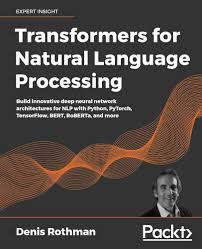A summary and White Paper on Transformers for Natural Language Processing, including Python, PyTorch, TensorFlow, BERT, RoBERTa, and more. Include references.
Summary:
Transformers have revolutionized the field of Natural Language Processing (NLP) by introducing a novel architecture that enables deep neural networks to capture long-range dependencies in text data. This summary provides an overview of transformers, their key components, benefits, and popular implementations, such as BERT and RoBERTa.
Key Components:
- Self-Attention: A mechanism that allows the model to weigh the importance of different words or tokens in a sequence.
- Encoder-Decoder Architecture: A common architecture used in transformer models, consisting of an encoder that processes the input sequence and a decoder that generates the output sequence.
- Positional Encoding: A method to incorporate positional information into the input sequence, as transformers do not inherently understand the order of words.
Benefits:
- Improved Performance: Transformers have achieved state-of-the-art results on a wide range of NLP tasks, such as machine translation, text summarization, and question answering.
- Long-Range Dependencies: Transformers can effectively capture long-range dependencies in text data, which is crucial for many NLP tasks.
- Flexibility: Transformers can be adapted to various NLP tasks by changing the input and output formats.
Popular Implementations:
- BERT (Bidirectional Encoder Representations from Transformers): A pre-trained transformer model that has been fine-tuned for various NLP tasks.
- RoBERTa (Robustly Optimized BERT Pretraining Approach): A variant of BERT that incorporates several improvements to the training process.
- GPT (Generative Pre-trained Transformer): A transformer model designed for text generation tasks.
White Paper: Transformers for Natural Language Processing: Building Innovative Deep Neural Network Architectures
Introduction This white paper explores the concept of transformers and their applications in NLP. We will delve into the theoretical underpinnings of transformers, discuss their key components, and present practical examples and best practices for building transformer-based models.
Theoretical Foundations of Transformers
- Self-Attention Mechanism
- Encoder-Decoder Architecture
- Positional Encoding
Building Transformer-Based Models
- Data Preparation and Preprocessing
- Creating Transformer Architectures
- Training and Fine-Tuning
- Evaluation and Performance Metrics
Popular Transformer Models
- BERT
- RoBERTa
- GPT
- Other Notable Models
Applications of Transformers
- Machine Translation
- Text Summarization
- Question Answering
- Sentiment Analysis
- Text Generation
- Many Other NLP Tasks
Best Practices and Considerations
- Hyperparameter Tuning
- Transfer Learning
- Model Architecture Selection
- Computational Resources
Conclusion Transformers have emerged as a powerful tool for NLP, enabling the development of innovative deep neural network architectures. By understanding the theoretical foundations of transformers and following best practices, researchers and practitioners can leverage this technology to address a wide range of NLP challenges.
Reference List:
- Attention Is All You Need: https://arxiv.org/abs/1706.03762
- BERT: Pre-training of Deep Bidirectional Transformers
- RoBERTa: A Robustly Optimized BERT Pretraining Approach: https://arxiv.org/abs/1907.11692
- GPT-2: Understanding the Nature of Language: https://openai.com/blog/better-language-models/
- PyTorch: https://pytorch.org/
- TensorFlow: https://www.tensorflow.org/
Note: This is a general outline for the white paper. You can expand on each section, provide more technical details, and include specific examples and code snippets to illustrate the concepts. Contact ias-research.com for details. Contct keencomputer.com for details.



